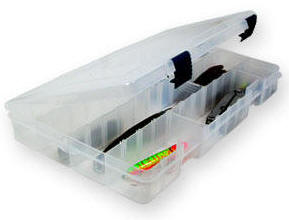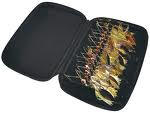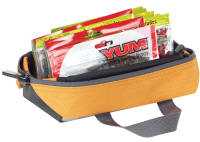|
Tackle Organizing Tips
By Lawrence Euteneier
When I could still see enough to read fishing
magazines in my teens, large multi-level tackle
boxes were in style. Monster double-tiered
affairs that would open up to unveil tier upon
tier of lures in all their colourful glory. I
purchased a seven-tier box myself and used it
for years. However, due to the large foot-print
these puppies took up in a boat when opened they
eventually fell out of favour with fishers, many
of whom have now adopted tackle trey storage
solutions.
 My
personal favourite Plano Tray is the thinnest
unit (3700). The trey offers sufficient rows (5)
and dividers to hold a variety of baits, but is
shallow enough to discourage stuffing more than
two lures in any one compartment. Their thin
size also means more treys can be carried in one
soft tackle carry-on bag, and more thin treys is
better than fewer deep treys, from an organizing
perspective. Trey identification can be
facilitated through Labels applied directly with
a marker, (permanently), or with the optional
coloured clasps. My
personal favourite Plano Tray is the thinnest
unit (3700). The trey offers sufficient rows (5)
and dividers to hold a variety of baits, but is
shallow enough to discourage stuffing more than
two lures in any one compartment. Their thin
size also means more treys can be carried in one
soft tackle carry-on bag, and more thin treys is
better than fewer deep treys, from an organizing
perspective. Trey identification can be
facilitated through Labels applied directly with
a marker, (permanently), or with the optional
coloured clasps.
Crankbaits
Crankbaits are organized around themes based on
species of fish and fishing technique. For
example, for Bass I have a trey made up
specifically of floating / suspending jerk
baits, and another of poppers and prop baits,
etc. Marking the running depth on the diving
lips of lures eliminates confusion.
Soft Plastic Baits
The zip-lock pouches soft plastics come in are
generally of a sufficient quality that one feels
bad discarding them. Pouches can be organized in
a deep 3780 size Plano tray by theme, (style of
bait, application, colour, etc.). I keep my
plastic baits at home organized in this fashion.
This size Plano trey is large however, and
unless you have lots of on-board storage space
in your own boat, transporting 3-4 of these
treys in your tackle bag can pretty much fill
the bag. Others have dumped their plastics
directly into plastic treys, but Plano
recommends not storing plastic baits in direct
contact with their treys as the chemical
reaction will cause the trey, lid and dividers
to warp, an issue common with most all plastic
trays.
Iíve experimented with soft wallet organizers
like those sold by Bass Pro Shop. Great idea,
but if you donít want to dump the plastic baits
out of their original pouches, your going to
experience problems fitting the pouches into the
BPS walletís sleeves. Plano makes similar small
soft zippered sleeveless bags (SpeedBags) for
organizing plastic baits in their original
pouches which I actually prefer. I organize each
bag around a specific style of bait, and then
arrange the baits into the bag using a lightest
to darkest theme. Hooks, weights and other
terminal tackle associated with fishing the
baits can be inserted into the bags in their
original packaging. Attach a key-tag or plastic
baggage label to the handle of the SpeedBag to
identify each bags contents.
Gulp Alive
Both Berkley and Plano have now come
out with new storage containers to hold and
organize your Gulp baits. Many fishers find the
original plastic buckets that Gulp Alive come in
leek once you remove the seal. This can be
prevented by cutting a whole through the seal
instead of removing the seal altogether, but
this still leaves the fisher with a collection
of large plastic buckets that are still prone to
leek if lids arenít properly secured. Plastic
Tupperware with the lock-down lids are
excellent, and zip-lock baggies work well when
wait is an issue
Really, Gulp Alive has simply inherited many of
the same problems fishers have with storing live
bait, minus the mortality issues. A little tip,
donít cut your Gulp juice with water as the
juice contains a very important preservative
without which the Gulp Alive baits will rot and
omit a potent odour similar to dead minnows.
Spinnerbaits:
When it comes to storing spinnerbaits,
Iíve tried it all. From simply bending the bait
into a circle
 and
inserting the hook point through one of the
blade split rings and hooking the barb, to
spinnerbait boxes that hang your baits in a row,
to Planoís spinnerbait box with the individual
hard plastic sleeves. In the end however, Iíve
gone with the soft BPS wallet. One small-sized
wallet organized from lightest to darkest. When
I get new bait, I can always add it to an
existing sleeve or introduce a new sleeve into
the wallet. and
inserting the hook point through one of the
blade split rings and hooking the barb, to
spinnerbait boxes that hang your baits in a row,
to Planoís spinnerbait box with the individual
hard plastic sleeves. In the end however, Iíve
gone with the soft BPS wallet. One small-sized
wallet organized from lightest to darkest. When
I get new bait, I can always add it to an
existing sleeve or introduce a new sleeve into
the wallet.
Spinners and Spoons
I store my spinners and spoons in, what
else, Plano 3700 treys. Organized by size pretty
much gives me the species specific themes Iím
looking for.
Hooks, Weights and Swivels
Keeping the number of small individual
packages in the tackle bag to a minimum will
help reduce clutter or things flying off the
boat during transit. Larger cluster packaging
organized on different themes means more
efficient access to tackle and fewer lost items.
For years I recycled vitamin bottles and 35mm
film containers, but their accumulation can
quickly over-whelm a tackle bag making finding
specific items a challenge. I switched to
stacking jars from Plano. These handy plastic
jars use the bottom of the jar on top as a lid
for the one below, and so on, with one lid to
top off the stack. One stack for all my
split-shots, another for circle hooks, etc.
Avoid piling your stacking towers to high to
minimize tipping issues.
 For
my larger-sized hooks I use two smaller sized
trays Ė one for weighted and the other not. Or,
to lighten the load, I simply insert the
original hook packages into the Plano SpeedBags
along side their intended plastics. For
drop-shot hooks and other finesse hooks, I use a
large fly box. You can fit quite an assortment
into one water-proof box, and the points of the
hooks themselves are protected. For
my larger-sized hooks I use two smaller sized
trays Ė one for weighted and the other not. Or,
to lighten the load, I simply insert the
original hook packages into the Plano SpeedBags
along side their intended plastics. For
drop-shot hooks and other finesse hooks, I use a
large fly box. You can fit quite an assortment
into one water-proof box, and the points of the
hooks themselves are protected.
Jigs
A soft-sided BPS wallet with sleeves
labelled bright, natural and dark for each of my
swim and flipping jigs, repeated for the
different weights. Another wallet for my hair
jigs, and a Plano 3500 trey for jigs such as
Football, shaky, tube, etc. I re-stock my
wallets and trey after each trip, keeping
numbers and weight in the tackle bag to a
minimum.
Transportation
Itís all too easy to leave behind a
tackle bag or favourite rod at dock side. Itís a
loss that can be profoundly disturbing. Thereís
no doubt haste and fatigue can result in memory
lapses, making it difficult to keep track of
multiple items of baggage. To reduce the odds of
this happening to you, use the largest tackle
bag capable of containing all the gear youíll
need for the day. Pack personal gear such as a
rain suit, sun protection, lunch, beverages,
etc) in a second bag, and bundle your rods with
velcro straps. Three items into the boat in the
morning, and three things into the truck at the
end. Keep your PDF on during launching and
loading so forgetting it wonít be an issue. One
last check in the truck and a walk around the
rig looking above and below is a wise final step
before heading home.
Rust
Wet tackle rusts quickly and most
storage containers arenít waterproof. Even if
they are, one needs to be sure that lures arenít
re-stocked wet. Iíve installed thin foam
strips on the top of each console for holding
wet lures until they dry. At the end of a dayís
fishing, I collect the lures I was using from
the console and either replace them in their
treys or wallets or, if their still wet, dump
them in a zip-lock for drying later at home.
Some how these baits usually end up on my desk
where they serve as both tactile mementos of the
dayís success, or reminders of what I should
have done differently.
Conclusion
Naturally, I left out all the details
about applying braille and such, which can be
found on my website at
www.blindfishingboat.com . Sightless or not
though, you can never be too organized, as no
matter how hard one tries there always seems to
be a crucial piece missing from the kit that
tests ones patience and ingenuity.
Anchors Up,
Captain Lawrence Euteneier
www.BlindFishingBoat.Com
|